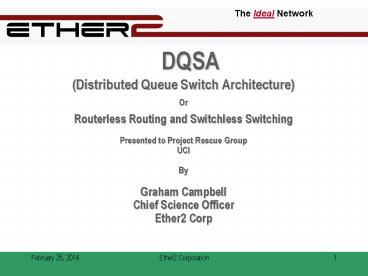DQSA PowerPoint PPT Presentation
1 / 24
Title: DQSA
1
The Ideal Network
- DQSA
- (Distributed Queue Switch Architecture)
- Or
- Routerless Routing and Switchless Switching
- Presented to Project Rescue Group
- UCI
- By
- Graham Campbell
- Chief Science Officer
- Ether2 Corp
2
Introduction
- DQSA (Distributed Queue Switch Architecture) is a
family of protocols developed at The Illinois
Institute of Technology. - Basis of DQSA is almost ideal MAC (medium access
control) that is effective regardless of speed,
distance, or medium. - Ether2 Corp. has acquired the exclusive rights to
this patented technology.
3
Background of MACs
- The telephone party line utilized one of the
earlier MACs which was either good manners or
hollering louder. - Communications between computers is subject to
same economics - Direct connections often underutilized
- A plus - machines, unlike humans, can increase
transmission rate. - Hollering was no longer a solution.
- How did computer communications develop?
- Introduction of Aloha at U of Hawaii in the late
60s started search for ideal MAC.
4
Characteristics of the Ideal MAC
1. Immediate Access. 2. Bus Fully Utilized. 3.
Average Delay that of M/D/1 Queue. 4. Delay is
Predictable. 5. FIFO with Optional Priorities.
6 Distributed Control - No Master Station. 7.
QoS - Provide Guaranteed Bandwidth. 8. Topology
Independent. 9. Idle Nodes do not use
Resources. 10. Serves geographic area of any
size. Only 1, 6, 8 and 9 supported by Ethernet.
5
A Router Has Five Characteristics
6
DQSA Has Everything -- How?
- DQSA utilizes, in addition to a data slot, three
control minislots (CMS) that are used to (1)
reserve data slot(s), and (2) resolve contention. - DQSA utilizes features of existing protocols
- Aloha/CSMA
- Control Minislots
- DQDB
- Stack Protocols
- Next slide compares DQSA with the ideal, note the
reasonable delay at 0.95 traffic.
7
DQSA Delay
8
COMPARISON OF THROUGHPUT
S ( Throughput )
1
0.8
0.6
0.4
0.2
0.01 0.1
1.0
10 100
G ( Offered Load )
9
PDQSA (Priority DQSA) (Mixture of High and Normal
Priority Traffic)
10
XDQSA(Extended DQSA)
- In the seminal DQSA protocol (DQRAP), each
transmission into a CMS is a request to reserve a
single dataslot. - In XDQSA each transmission in a CMS is a request
to reserve a multiple number of dataslots. - Variable length packets are segmented and the
segments (cells) transmitted with no further
encapsulation. - Big Plus! XDQRAP requires but two minislots to
achieve 100 utilization of dataslots.
11
DQSA Segmentation and Transmission
Minislot request from another station
12
How Robust is DQSA?
- Arrival of multiplicity N is resolved in less
than N dataslots ensuring 100 throughput. - Errors in reading CMS and retransmission in CMS
do not affect data transmission unless arrival of
multiplicity N not resolved in N dataslots. - DQSA can sustain up to 10 error rate in cms
before data throughput drops below 1.
13
How About QoS?
- DQSA provides three general levels of service
- Best Effort Equivalent to conventional
transmissions under DQSA where average delay is
8.25 slots at offered traffic of 90. - Priority using PDQ Delay equivalent to lightly
loaded network. PDQ provides 4 slot delay for
20 high priority in 90 total traffic. - Guaranteed Service DQSA provides equivalent of
TDM-like channels intermixed with random access. - DQSA supports intermixed synchronous and
asynchronous traffic.
14
Why DQSA Works
- In networks traffic tends to converge before
diverging. Often expensive switches are
functioning as congestion prone hubs. - Networks since the time of Bell have been
designed to support actual traffic rather than
potential traffic. Telcos make best return on
investment by selling capacity that is not used,
e.g., over-subscribing. - DQSA is the ideal architecture for both of the
above perfect queuing makes for both optimal
convergence and for supporting over-subscription. - Let us look at examples.
15
A DQSA G.shdsl System
Ether2 QMux -- a DSLAM Replacement at much
less cost. Supports QoS. Output speed flexible
from T1 to OC3. ATM or IP.
Up to 32 ports. Multiple 32-port units can be
ganged to a single output port.
16
Support Voice, Video and Data in Combat
17
A DQSA SAN
18
DQSA and Cell Systems
- Supports up to three times number of calls.
- Carrier signaling and spread spectrum.
- Dynamically allocated fixed-bandwidth channels
intermixed with voice packets. - Overloading accommodated .
19
DQSA Eliminates the Routers
Legend
- Carriers utilize their basic SDH synchronous
plant, e.g., T1, DS3, OCx.
HQ DataBase
- Customer offices are connected to their
respective virtual or physical private networks
via Ether2 IADs/NICs. The latter connect directly
into the SDH infrastructure.
Branch Office
Customer Premises Ether2 IAD/NIC
20
Ether2 Ethernet-Compatible Cluster
21
Features of DQSA in Clusters
- Fairness
- Global Operations
- Multicast/Broadcast
- Channels
- Full utilization with short messages
- Low Latency
1 Gbps 2 Gbps 5 Gbps 10 Gbps 40 Gbps
Latency (µsecs) (4.5 slots) 4.0 1.6 0.8 0.4 4 x Prop Delay
22
Ease of Implementation
- The basic DQSA network consists of a four-state
logic machine at each node. - Sits above the physical layer any medium, and
below the network layer DQSA just slides in. - A DQSA switch can look like an Ethernet switch,
an ATM switch, an IP switch, or any other type of
switch. - Potential applications virtually unlimited.
23
CDQ (Cascaded Distributed Queue)
- CDQ utilizes the Qnode. The Qnode provides the
equivalent of a routing function by reducing the
routing decision to a yes or no thus
eliminating congestion. Local DQSA networks are
attached between the Qnodes.
24
Conclusion
- DQSA represents a paradigm shift in switching.
- DQSA will enable final convergence of voice,
video and data. - Ether2 has built 12 NICs and two hubs and will be
developing software on a prototype 100 Mbps
cluster in the next 3 months. - Ether2 is interested in partnering.
- Graham Campbell 310.913.4383 gcampbell_at_ether2.co
m

